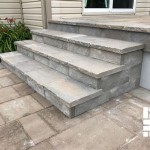Building a Roof Over a Concrete Patio: A Comprehensive Guide
Adding a roof over an existing concrete patio significantly enhances its usability and value. A covered patio provides protection from the elements, extending the outdoor season and creating a more comfortable space for relaxation and entertainment. This article provides a detailed overview of the process involved in constructing a roof over a concrete patio, covering essential considerations, design options, structural elements, and step-by-step building instructions.
Before embarking on the project, careful planning and preparation are crucial. This includes obtaining necessary permits, designing the roof structure to complement the existing architecture, and gathering the required tools and materials. Ensuring compliance with local building codes is paramount to avoid potential legal issues and ensure the safety and longevity of the structure.
Planning and Design Considerations
The initial phase involves a thorough assessment of the existing patio and determining the desired specifications for the new roof. Key factors to consider include the size and shape of the patio, the intended use of the covered space, existing structures, and local building codes. The design should integrate seamlessly with the architectural style of the house and provide adequate protection from sun, rain, and wind.
Permits are a necessity in most jurisdictions before any construction project begins, especially when dealing with permanent structures like a patio roof. Contacting the local building department to determine specific requirements for patio covers is an essential first step. This will involve submitting architectural drawings and details regarding the structure's design. It is also important to verify setback requirements or other restrictions applicable to the property.
Choosing the right design is vital for both aesthetics and function. Gable roofs offer good drainage and a classic look. Shed roofs are simpler to construct and ideal for contemporary homes. A flat or pergola-style roof might be desirable for a more open feel, but these structures typically require different materials and engineering. The choice also affects the height and slope of the roof, which influences material requirements and structural support needs.
The selection of materials greatly influences the durability, appearance, and cost of the patio roof. Pressure-treated lumber is commonly used for framing due to its resistance to rot and insects. Roofing materials can range from asphalt shingles, which are economical and widely available, to metal roofing, which offers longevity and energy efficiency. Clear polycarbonate panels can provide protection from the elements while allowing natural light to filter through. Consider the maintenance requirements of each material when making the selection.
Proper drainage is essential to prevent water damage and ensure the longevity of the roof structure. Gutters and downspouts should be installed to efficiently channel rainwater away from the patio and foundation. The slope of the roof should be specified to facilitate adequate water runoff. Ensuring that the drainage system effectively manages water flow is a crucial aspect of the design phase.
Structural Elements and Support Systems
The structural integrity of the patio roof depends on a well-designed and properly constructed support system. This typically consists of posts, beams, and rafters, which must be sized and spaced according to the roof's span, weight, and local wind and snow load requirements. The foundation for the posts must be strong and stable to ensure the roof can withstand environmental stressors.
Posts provide the primary vertical support for the roof structure. These are typically made of pressure-treated lumber or metal and should be securely anchored to the existing concrete patio. The size and spacing of the posts will depend on the overall size and design of the roof. In many cases, attaching the posts to concrete footings below the patio slab will offer greater stability and structural integrity. This requires removing a section of the concrete and pouring new footings that extend below the frost line.
Beams span the distance between the posts and provide horizontal support for the rafters. The size and number of beams required will depend on the span and the weight of the roof. Laminated beams or engineered lumber may offer greater strength and stability compared to standard lumber, particularly for longer spans. Beams should be securely attached to the posts using appropriate hardware, such as bolts and brackets.
Rafters are the structural members that support the roofing material. They are typically spaced at regular intervals, such as 16 or 24 inches on center, and run from the beam to the house or a header board. The size and spacing of the rafters will depend on the type of roofing material and the roof's pitch. Rafters should be securely attached to the beams and header board using nails or screws.
Connecting the roof to the existing house requires careful consideration to ensure a weathertight seal and prevent water damage. Flashing should be installed where the roof meets the house to prevent water from seeping behind the siding. The attachment point should be structurally sound and able to support the weight of the roof. Consider consulting with a structural engineer to ensure the connection is properly designed and installed.
Step-by-Step Building Instructions
With the design complete and materials gathered, the construction phase can begin. This requires a systematic approach, starting with the foundation and support system and progressing to the roof framing and finishing details. Accurate measurements and careful execution are essential to ensure a structurally sound and aesthetically pleasing final product.
The initial step involves preparing the concrete patio for the post foundations. This typically involves marking the locations for the posts, cutting away sections of the concrete to access the ground below, and excavating holes for the footings. The size and depth of the holes will depend on local building codes and soil conditions. Pouring concrete into the holes to create solid footings is a critical step in providing a stable foundation for the posts.
Once the concrete footings have cured, the posts can be installed. The posts should be plumb and level and securely anchored to the footings using appropriate hardware. This may involve embedding anchor bolts in the concrete or using post bases that are bolted to the footings. Accurate alignment of the posts is crucial for the overall structural integrity of the roof.
With the posts in place, the beams can be installed to span the distance between the posts. The beams should be securely attached to the posts using bolts, brackets, or other appropriate hardware. Ensuring that the beams are level and properly aligned is essential for evenly distributing the roof's weight across the support system.
Next, the rafters are installed, running from the beam to the house or a header board. The rafters should be spaced at regular intervals and securely attached to the beam and header board using nails or screws. Installing sheathing, such as plywood or OSB, over the rafters provides a solid surface for the roofing material. The sheathing should be securely fastened to the rafters with nails or screws.
The final step involves installing the chosen roofing material, such as asphalt shingles, metal roofing, or polycarbonate panels. Follow the manufacturer's instructions for installation to ensure a weathertight seal and proper performance. Install gutters and downspouts to efficiently channel rainwater away from the patio and foundation. Completing the finishing details, such as trim and paint, will enhance the appearance and durability of the patio roof.
Safety precautions are paramount throughout the construction process. Wearing appropriate safety gear, such as eye protection, gloves, and a hard hat, is essential. Use power tools safely and follow manufacturer's instructions. If uncertain about any aspect of the construction process, consult with a qualified contractor or structural engineer.
Building a roof over a concrete patio is a significant undertaking that requires careful planning, preparation, and execution. By following these guidelines and adhering to local building codes, a homeowner can successfully create a functional and aesthetically pleasing outdoor living space that will be enjoyed for years to come.

Diy Turning A Concrete Slab Into Covered Deck Catz In The Kitchen

Diy Turning A Concrete Slab Into Covered Deck Catz In The Kitchen

Diy Patio Part2 Framing Roof

Porch Roof Construction How To Build Designs Pergola Patio Truss Design

Diy Covered Patio Building A Roof To Cover My Concrete P1 Foundation Framing Roofing

Building A Patio Cover Plans For An Almost Free Standing Roof

Diy Patio Roof Handybros

Patio Roof Gazebo Construction Hometips Diy

Patio Cover Plans Build Your Or Deck

How Much Does It Cost To Build A Roof Over My Deck 2024 Data
Related Posts








